Leipzig
![]()
This article is about the city in Saxony. For other meanings, see Leipzig (disambiguation).
Leipzig ([ˈlaɪ̯pt͡sɪç]; in Saxon dialect also Leibzsch [ˈlaɪ̯bt͡sʃ]) is an independent city as well as the most populous city in the Free State of Saxony with 597,493 inhabitants (31 December 2020) and ranked eighth in the list of large cities in Germany in 2019. For Central Germany, it is a historical center of business, trade and transport, administration, culture and education, and currently a center for the "creative scene".
Leipzig is one of the six major centres in Saxony and, together with the city of Halle (Saale) in the state of Saxony-Anhalt, which is around 35 kilometres away, forms the cross-border conurbation of Leipzig-Halle, which is home to around 1.1 million people. Together with Halle and other cities in the states of Saxony, Saxony-Anhalt and Thuringia, Leipzig is part of the polycentric metropolitan region of Central Germany.
After being granted city rights and market privileges around the year 1165, Leipzig already developed into an important trading centre during the German settlement in the East. Leipzig's tradition as an important trade fair location in Central Europe with one of the oldest trade fairs in the world dates back to 1190 and was closely linked to Leipzig's long-standing role as an international centre of the fur trade. During the Nazi era, Leipzig officially held the honorary title of Reichsmessestadt from 1937 to 1945. The city is a historical center of book printing and trade. Leipzig is also home to one of the oldest universities and the oldest colleges of both commerce and music in Germany. Leipzig has a great musical tradition, which goes back mainly to the work of Johann Sebastian Bach and Felix Mendelssohn Bartholdy and is based, among other things, on the importance of the Gewandhaus Orchestra and the St. Thomas Boys Choir.
In the course of the Monday demonstrations in 1989, which provided a decisive impetus for the turnaround in the German Democratic Republic (GDR), Leipzig was dubbed Hero City. The informal distinction for the so courageous as well as peaceful commitment of many Leipzig citizens in the vicinity of Leipzig's St. Nicholas Church shaped the city's reputation after the reunification and is taken up in the city's marketing under the motto "Leipzig Freedom". In addition, Leipzig is known for its wealth of elaborately restored or reconstructed cultural monuments and urban canals, the species-rich zoo, as well as the Leipzig Neuseenland, which was created by recultivating former open-cast lignite mines, and the Bundesliga club RB Leipzig.
Leipzig is home to the Federal Administrative Court, the 5th and 6th Criminal Senates of the Federal Court of Justice, and, since 1 October 2018, the Federal Highway Authority, which began operations on 1 January 2021.
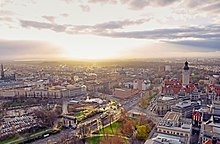
View from the City-Hochhaus in south-west direction: on the right New City Hall, on the left Propsteikirche St. Trinitatis, in the background Federal Administrative Court and Leipzig's Auwald forest (2015)

New town hall, since 1905 seat of the city administration (2013)
.jpg)
Leipzig Market with Old Town Hall (2019)
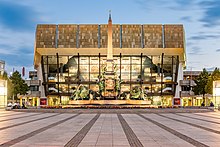
Gewandhaus zu Leipzig at Augustusplatz (2016)
.jpg)
Promenades at Leipzig Central Station (2013)
Geography
Location and morphology
Leipzig is located in the centre of the Leipzig Lowland Bay, which forms the southernmost part of the North German Plain, and at the confluence of the Weißer Elster, Pleiße and Parthe rivers. The rivers branch out in many ways in the city area, forming the Leipziger Gewässerknoten, which is accompanied by a large alluvial forest area (see following section). The surrounding area of Leipzig is sparsely wooded. The area was characterised by extensive open-cast lignite mining in the 20th century, as a result of which numerous lakes are now being created.
The extent of the city is 23.4 kilometers in the north-south direction and 21.3 kilometers in the east-west direction. The length of the city boundary is 128.7 kilometres. In the north the administrative district Nordsachsen borders on the city, in the south the administrative district Leipzig.
| Magdeburg (130 km) | Rostock (380 km) | Berlin (190 km) |
| Kassel (230 km) |
| Dresden (110 km) |
| Erfurt (140 km) | Zwickau (85 km) | Chemnitz (80 km) |
* Distances are rounded road kilometres to the town centre.
The difference in altitude in the city area is about 60 meters. The higher parts are in the southeast and the lower in the northwest. The lowest point with 97 meters above sea level is located at the Neue Luppe near Gundorf. The highest natural points of the city are with 159 meters the Monarch Hill and with 163 meters the Galgenberg in Liebertwolkwitz. The Monarch's Hill is surpassed by the Seehausen (178 m) and Liebertwolkwitz (177 m) landfills, and an elevation close to the city centre is the rubble mountain called Fockeberg (153 m).
Although the Weiße Elster is the most water-rich of the three rivers in the city area, the Pleiße is the one most associated with Leipzig, as it is closest to the city centre with its tributary, the Pleißemühlgraben.
Land use
The graph shows the proportions of land use in the city area in 2014.

Nature and environment
Along the rivers, an extensive floodplain forest area runs in a north-south direction through the city, which has been partially converted into parks in the central area. The floodplain forest forms a climatically, ecologically and recreationally relevant green connection from the Leipzig hinterland to the core city and has preserved a rare flora and fauna despite centuries of direct anthropogenic influence. The close link between the alluvial forest and urban development is a unique feature of Leipzig in Europe.
As there are significant lignite deposits under Leipzig and its surrounding area, industrial mining of this raw material in opencast form began as early as the 1930s. As a result of mining, which continued to expand during the GDR period (lignite was the GDR's main source of energy), parts of the alluvial forest south of Leipzig were destroyed. Numerous flood protection measures, including the construction of the Elster basin and the relocation of natural river courses, as well as lowering of the groundwater level associated with lignite mining, led to disturbances of the highly specialised ecosystem that originally served as a natural floodplain.
The city lies in the middle of Leipzig's watercourse node, a former inland delta that was frequently reshaped, for example, by the construction of mill ditches and flood protection facilities. In the 1950s, the Pleißemühlgraben and part of the Elstermühlgraben - tributaries of the two rivers Pleiße and Weiße Elster, some of them artificially created in the Middle Ages for the operation of mills - were piped or filled in south of Leipzig because of pollution by industrial wastewater from lignite processing, so that Leipzig partially lost its character as a river city. The discharge of the highly toxic waste water had led to the rivers becoming biologically dead. Since the end of the water polluting industry at the beginning of the 1990s, both river courses are gradually being reopened. Around 141 kilometres of permanently flowing watercourses run through the city area, in addition to streams and ditches that only carry water temporarily.
See also: Water bodies in Leipzig
In addition to the water pollution, the lignite firing of outdated industrial plants, some of which still corresponded to pre-war standards, as well as domestic stove heating systems, brought with them very severe air pollution. The sulphurous and phenolic air and the accompanying acid rain attacked parts of the building fabric, especially those made of sandstone. In the 1970s and 1980s Leipzig was considered one of the most polluted cities in Europe. After the "Wende", the closure of old industries and the modernisation of power stations and domestic heating systems very quickly led to much improved water and air conditions and a visible recovery of the animal and plant world. Leipzig is one of the greenest cities in Germany with its numerous city parks, such as the Clara-Zetkin-Park near the city centre and the Rosental, many newly created parks in the residential areas as well as the traditional allotment garden associations. The proportion of green spaces is estimated at around 50 %, the proportion of forest at around 7 %. By 2015, the proportion of forest is to be increased to 10% and biotope networks are to be expanded. Since 2007, Leipzig has been a model region for the testing and development project "Urban Forest Areas" of the Federal Agency for Nature Conservation, whereby forests of various types are to be established on inner-city brownfield sites in cooperation with the responsible city authorities and their effect on climate, recreational provision and nature conservation is to be investigated. There are potential areas of around 1850 hectares in the inner-city area.
See also: Parks and gardens and nature reserves in Leipzig
Street trees play a significant role in Leipzig's urban greenery, fulfilling both design and ecological functions. There are currently 57,732 street trees registered in the city's tree cadastre. This is more than the registered park trees. Of the street trees, over 35% are linden trees, fitting for the origin of the city's name. 38% of street trees are less than 20 years old, resulting from both the addition of old stands and the immediate planting of newly constructed streets. Since the start of the Baumstarke Stadt campaign in 1996, donations (from EUR 250 per tree) have enabled up to 150 trees to be planted each year.
At the beginning of the 1990s, lignite mining was stopped and the recultivation of the opencast pits and the renaturation of the surrounding area began. In the meantime, several lakes with very good water quality have been created from the flooded opencast mines. Further opencast mines are still being flooded. Lakes Kulkwitz and Cospuden are the closest to Leipzig's city centre and serve as very well developed local recreation areas. In addition, the Leipzig city area also borders on Lake Zwenkau, which is to be connected to Lake Cospuden by a canal. The resulting large recreational area will be marketed to tourists as the "Leipziger Neuseenland" and is expected to cover 70 km² of water when completed. In the city area itself, around 130 still waters with a total area of 80 hectares are under municipal management. In order to develop nature and the landscape of the region together with the surrounding municipalities and districts and to make it possible to experience them, Leipzig has been a member of the Green Ring Leipzig since 1996.
On 1 March 2011, a large part of the city was declared a low emission zone of pollutant group 4.
City structure and neighbouring municipalities
See also: List of districts of Leipzig and List of boroughs and districts of Leipzig
Since 1992, Leipzig has been divided administratively into ten boroughs, which contain 63 districts. In contrast, city districts are areas of the city that were created by incorporating previously independent villages. Therefore, the boundaries of city districts and local districts are not always identical. To achieve administrative units of approximately the same size, sometimes two city districts form a local district, or a city district is split into several local districts. If not created by incorporation, sometimes a district does not correspond to a city district.
| |||||||||||||||||||||||||||||||||||||||||||||||||
| The neighbouring municipalities of Leipzig | |||
| Krostitz | Jesewitz | ||
| Schkeuditz | Rackwitz | Taucha | |
| Markranstädt |
| Borsdorf | Brandis |
| Pegau | Markkleeberg | Großpösna | |
| Zwenkau | |||
Krostitz, Jesewitz, Schkeuditz, Rackwitz and Taucha are in the district of Nordsachsen, Borsdorf, Brandis, Markranstädt, Markkleeberg, Pegau, Zwenkau and Großpösna in the district of Leipzig.
See also: List of streets and squares in Leipzig
Climate
Leipzig is located in the temperate climate zone, in the transition area from the oceanic climate of Western Europe to the continental climate of Eastern Europe. The average annual temperature is 8.4 °C and the average annual precipitation is 507 mm (average 1972-2001). On average, there were 77 days with frost, 37 summer days and over seven hot days in the same period. Most precipitation falls in the summer months of June to August, with a peak of 58.6 mm in August. February has the least precipitation with 27 mm, while in the other winter months it is around 30 mm.
The rain shadow of the Harz reaches its southeastern border in the Leipzig city area. To the south, the rainfall doldrums of the Ore Mountains join in. This manifests itself in a significant precipitation gradient in the vicinity of the city, but also within the urban area. The driest area is the north of Leipzig, the most precipitation falls in the southern area of the city, with an annual difference of about 100 mm. By comparison, the city of Halle (Saale), which lies entirely in the rain shadow, receives only about 450 mm of precipitation per year.
The highest value was measured in Leipzig on 30 June 2019 with 38.7 °C. The lowest recorded temperature was recorded on 14 January 1987 with -24.1 °C.
| Leipzig | ||||||||||||||||||||||||||||||||||||||||||||||||
| Climate diagram | ||||||||||||||||||||||||||||||||||||||||||||||||
| ||||||||||||||||||||||||||||||||||||||||||||||||
| Monthly average temperatures and precipitation for Leipzig
Source: DWD, data: 2015-2020 | ||||||||||||||||||||||||||||||||||||||||||||||||||||||||||||||||||||||||||||||||||||||||||||||||||||||||||||||||||||||||||||||||||||||||||||||||||||||||||||||||||||||||||||||||||||||||||||||||||||||||||||||||||||||||||||||||||||||||||||||||||||||||||||
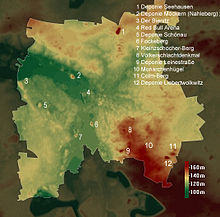
Relief map of Leipzig
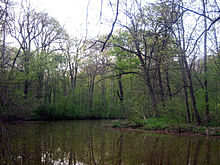
Pleiße in the southern alluvial forest (2007)
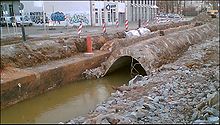
Exposure of a section of the piped Pleißenmühlgraben (2007)
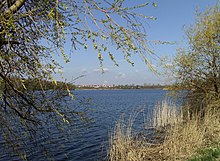
Lake Kulkwitz (2012)
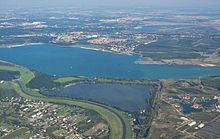
Lake Cospuden (2005)
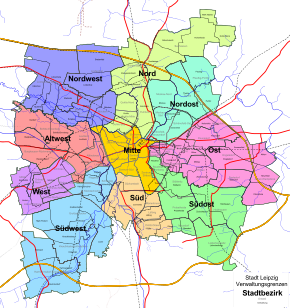
Location of the city boroughs, districts and city districts (Gemarkungen)
Politics
After the fall of communism in 1989, the "city council" (since 1991 again city council) was freely elected again. The first chairman from 1990 to 1994 was initially the city president Friedrich Magirius (non-party). Since 1994, the Lord Mayor has been the chairman of the City Council. Initially, the City Council elected the Lord Mayor, but since 1994 he has been directly elected by the citizens of Leipzig. The Lord Mayor of the city since March 2006 is Burkhard Jung (SPD). He replaced Wolfgang Tiefensee (SPD), who led the city affairs from 1998 to 2005, but resigned the office because of his appointment as Federal Minister of Transport on 22 November 2005. The Lord Mayor is supported by eight full-time aldermen, who bear the official title of mayor and are elected by the city council for a term of seven years.
Result of the city council election of May 26, 2019
Election of the Leipzig City Council 2019
as a percentage
%
30
20
10
0
21,4
20,7
17,5
14,9
12,4
4,8
3,8
2,5
1,4
0,6
Left
Green
CDU
AfD
SPD
FDP
PARTEI
WVL
Pirates
Otherwise.
gains and losses
compared to 2014
%p
10
8
6
4
2
0
-2
-4
-6
-8
−2,8
+5,7
−7,4
+8,9
−6,0
+1,9
+2,7
+0,7
−0,6
−3,1
Left
Green
CDU
AfD
SPD
FDP
PARTEI
WVL
Pirates
Otherwise.
The Leipzig City Council has a total of 70 seats. Since the 2019 municipal elections, the Left Party and the Greens have been the strongest parties in the Leipzig City Council with 15 seats each. They thus replaced the CDU, which had 19 seats in the 2014-2019 election period and lost six seats in 2019. The strongest parliamentary group, on the other hand, is the Left Party, which forms a joint parliamentary group with the PARTEI and has a joint total of 17 seats.
In total, nine parties are represented in the current city council, forming six factions.
→ Main article: Results of the municipal elections in Leipzig
The results of the 2019 City Council elections were as follows:
| Parties and Voters' Associations | Percent2019 | Seats2019 | Percent2014 | Seats2014 | Percentage2009 | Seats2009 | Percentage2004 | Seats2004 | |
| THE LEFT. | THE LEFT. | 21,4 | 15 | 24,2 | 18 | 23,1 | 17 | 26,1 | 19 |
| GREEN | Bündnis 90/The Greens | 20,7 | 15 | 15,0 | 11 | 14,7 | 10 | 10,0 | 7 |
| CDU | Christian Democratic Union of Germany | 17,5 | 13 | 24,9 | 19 | 23,6 | 17 | 25,5 | 19 |
| AfD | Alternative for Germany | 14,9 | 11 | 6,0 | 4 | - – | - – | - – | - – |
| SPD | Social Democratic Party of Germany | 12,4 | 9 | 18,4 | 13 | 20,4 | 14 | 26,9 | 19 |
| FDP | Liberal Democratic Party | 4,8 | 3 | 2,9 | 2 | 9,6 | 7 | 4,5 | 3 |
| The PARTY | Party for labour, rule of law, animal protection, elite promotion and grassroots democratic initiative | 3,8 | 2 | 1,1 | - – | - – | - – | - – | - – |
| WVL | Leipzig voters' association | 2,5 | 1 | 1,8 | 1 | 3,0 | 2 | - – | - – |
| PIRATES | Pirate Party Germany | 1,4 | 1 | 2,0 | 1 | - – | - – | - – | - – |
| NPD | National Democratic Party of Germany | - – | - – | 2,5 | 1 | 2,9 | 2 | - – | - – |
| NEW FORUM | NEW FORUM | - – | - – | 1,1 | - – | 1,7 | 1 | 1,6 | 1 |
| DSU | German Social Union | - – | - – | - – | - – | 1,0 | - – | 1,8 | 1 |
| Total | 100,0 | 70 | 100,0 | 70 | 100,0 | 70 | 100,0 | 70 | |
| Voter turnout in percent | 59,7 | 41,8 | 41,4 | 38,6 | |||||
After the city council election 2019 the following factions have been formed: DIE LINKE (17 members, incl. Die PARTEI), GRÜNE (16 members, incl. WVL), CDU (13 members), AfD (11 members), SPD (9 members), Freibeuter (4 members, incl. FDP + PIRATEN).
Result of the last mayoral election
→ Main article: List of mayors of the city of Leipzig
The last mayoral elections took place in spring 2020. In the first round of voting on 2 February 2020, incumbent Burkhard Jung (SPD) faced seven competitors. The voter turnout was 49.1 percent. As no candidate was able to garner an absolute majority of votes in the first round, the second round of voting was required, in which the top two finishers in the first round competed against each other after the other parties withdrew their candidates in order to support Burkhard Jung, although they would have been allowed to run for the second round under Saxony's municipal election law. The second round of voting, in which a simple majority is sufficient, took place on 1 March 2020. Burkhard Jung was elected Lord Mayor of Leipzig for the third time in a row with a turnout of 48.4%.
| Applicants | Party | First ballot | Second ballot |
| Sebastian Gemkow | CDU | 31,6 % | 47,6 % |
| Burkhard Jung | SPD | 29,8 % | 49,1 % |
| Franziska Riekewald | The Left | 13,5 % | unentered |
| Katharina Krefft | Green | 12,0 % | |
| Christopher Neumann | AfD | 8,7 % | |
| Catherine Subat | The PARTY | 2,4 % | |
| Marcus Viefeld | FDP | 1,2 % | |
| Ute Elisabeth Gabelmann | non-partisan | 0,9 % | 3,3 % |
1 candidate from Pirate Party, The Humanists, ÖDP and Democracy in Motion
Bundestag and federal politics
The city area is congruent with the constituencies 153 Leipzig I with a good 200,000 eligible voters and 154 Leipzig II with a good 210,000 eligible voters. From 2009 to 2017 Bettina Kudla (CDU) represented the constituency Leipzig I and Thomas Feist (CDU) the constituency Leipzig II. Thus, for the first time since 1998, the Leipzig direct mandates did not go to the SPD. In 2017, Jens Lehmann (CDU) was elected as a direct candidate in the Leipzig I constituency and Sören Pellmann (Die Linke) in the Leipzig II constituency.
The long-time Lord Mayor of Leipzig, Wolfgang Tiefensee, was Federal Minister of Transport, Building and Urban Development in the Merkel cabinet from 2005 to 2009, as well as the Federal Government Commissioner for the New Federal States. He was already offered this ministerial post by Gerhard Schröder after the 2002 elections, but turned it down on the grounds of his attachment to his work in Leipzig.
Country policy
Leipzig is divided into a total of seven state parliament constituencies. Since the 2019 state election, the CDU has held four of the seven direct mandates, with the remainder divided between the Greens (two mandates) and the Left (one mandate).
Coat of arms and flag
· 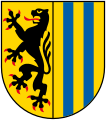
Coat of arms of the city of Leipzig
· 
Flag of the city of Leipzig
The coat of arms of the city of Leipzig shows in a split shield heraldically on the right in gold a red tongued and red armed black Meissen lion rising to the right, on the left in gold two blue Landsberg stakes.
The lion of the Mark of Meissen and the stakes of the Margraves of Landsberg are old Wettin coats of arms, which indicate the integration of the city of Leipzig into their dominion. The present coat of arms can be proved for the first time in 1468 as a seal, before that (around 1287) only a castle or a castle with the lion of the margraves could be seen on it. In the vernacular of the 17th century the following legend was told: The lion had once looked the other way and grabbed the stakes with its paws, but was later reversed "as punishment". In fact, on 15th century pennies the lion turns towards the stakes.
The difference to the Dresden coat of arms consists only in the tinging of the Landsberg stakes, that to the Chemnitz and Delitzscher coat of arms in the arrangement of the shields. In the coat of arms of the former district of Leipziger Land, a river was added to the Leipzig coat of arms.
The city colors are blue and yellow according to the coat of arms.
The city's flag consists of two equal horizontal stripes - blue at the top and yellow at the bottom - with the city's coat of arms applied.
Twinning
The city of Leipzig is twinned with:
Ukraine ![]() Kiev, Ukraine - since 1961, renewed 1992
Kiev, Ukraine - since 1961, renewed 1992
Italy ![]() Bologna, Italy - since 1962, renewed 1997
Bologna, Italy - since 1962, renewed 1997
Poland ![]() Krakow, Poland - since 1973, renewed 1995
Krakow, Poland - since 1973, renewed 1995
Czech Republic ![]() Brno, Czech Republic - since 1973, renewed 1999
Brno, Czech Republic - since 1973, renewed 1999
France ![]() Lyon, France - since 1981
Lyon, France - since 1981
Greece ![]() Thessaloniki, Greece - since 1984, renewed 2008
Thessaloniki, Greece - since 1984, renewed 2008
Germany ![]() Hanover, Germany - since 1987
Hanover, Germany - since 1987
China People's Republic of ![]() Nanjing, People's Republic of China - since 1988
Nanjing, People's Republic of China - since 1988
Germany![]() Frankfurt am Main, Germany - since 1990
Frankfurt am Main, Germany - since 1990
United Kingdom ![]() Birmingham, United Kingdom - since 1992
Birmingham, United Kingdom - since 1992
United States ![]() Houston, United States - since 1993
Houston, United States - since 1993
Bosnia and Herzegovina ![]() Travnik, Bosnia and Herzegovina - since 2003
Travnik, Bosnia and Herzegovina - since 2003
Athiopia ![]() Addis Ababa, Ethiopia - since 2004
Addis Ababa, Ethiopia - since 2004
Israel ![]() Herzlia, Israel - since 2011
Herzlia, Israel - since 2011
Consulates and missions abroad
There are several foreign missions in the city. However, of the 40 or so consulates that existed in Leipzig before the Second World War, very few returned after the fall of the Berlin Wall. The United States and Russia, for example, have a consulate general in Leipzig. Poland maintained a consulate general until 2008, and Greece until the end of 2010. Poland replaced this with an honorary consulate. Other countries that have established honorary consulates in Leipzig are Bosnia-Herzegovina, Costa Rica, the Democratic Republic of Congo, France, Italy, Kosovo, Liberia, Mongolia, Norway, Romania, the Slovak Republic, Sri Lanka and Ukraine. Poland maintains a Polish Institute in Leipzig as a branch of the Polish Institute Berlin. Leipzig is also home to a British Council, an Institut français and a Confucius Institute. Furthermore, in 2008 the Netherlands opened a "Netherlands Business Support Office" (NBSO) in Leipzig, which is responsible for economic contacts between the region and the Netherlands.
In order to deepen the cultural, economic or political exchange between Leipzig and other regions or states, several associations were founded, such as the German-Arab Cultural House, the German-Iraqi Association or the German-British Association.
Youth Parliament
From 23 to 29 March 2015, the first youth parliament was elected in Leipzig in an online election. The 20 elected parliamentarians aged 14 to 21 are to represent the interests of young people in the city. After Stuttgart and Trier, Leipzig is the third major city in Germany to establish such an institution. The legislative period lasts 2 years, so that elections were held again in 2017, 2019 and 2021.
Through the additionally established Youth Advisory Council, which consists of 8 members of the Youth Parliament and one representative from each city council faction, the Youth Parliament has the right to speak and make motions in the Leipzig City Council. The leadership of the public meetings of the committee as well as the organisational tasks are taken over by a "circle of spokespersons" elected by the members. The thematic work takes place mainly in the working groups, which are made up of members of the Youth Parliament and interested young people. In addition, the parliament is supported by a pedagogical supervision and an office. Furthermore, the committee has a youth fund through which projects by and for young people can be supported with a maximum of 500 euros within the framework of the federal programme "Live Democracy!
Advisory boards
In Leipzig there are ten municipal district advisory councils, 14 local advisory councils and ten specialist advisory councils. They are each made up of members of the city administration and elected or appointed knowledgeable residents. The advisory boards cannot make any legally binding decisions, but they are obliged to be heard and have the opportunity to raise matters themselves that have to be dealt with by the city council's committees.
There are the following advisory boards: Drug Advisory Board, Advisory Board for Equality, Advisory Board for Children and Families, Advisory Board for Migrants, Advisory Board for Psychiatry, Advisory Board for Seniors, Advisory Board for Disabled Persons, Advisory Board for Animal Protection and Advisory Board for Allotment Gardens.
The Migrant Advisory Council was established in 2009 and is elected every five years (last election 2021). It consists of 22 members, of which six are representatives of parliamentary groups and 16 are migrants. The office of the advisory board is the responsibility of the Department for Migration and Integration.
All foreigners who have a valid residence permit or a toleration permit, naturalised persons and ethnic German immigrants who have reached the age of 18 on election day and have been permanently resident in Leipzig for at least three months are entitled to vote.
Ten members are freely elected on the basis of regions of origin (North Africa, West and Central Asia, South and Central America, North, West and Central Europe, Southeast Asia and other Asia, South and Eastern Europe, North America, Australia, Oceania and Sub-Saharan Africa). All persons eligible to vote may apply. The remaining twelve members are composed of six representatives of the city council factions and six persons appointed by the city administration.

Plaque on the Leipziger Straße in Kiev, one of Leipzig's twin cities (2009)
.jpg)
Acting Lord Mayor Burkhard Jung (2015)
Questions and Answers
Q: Where is Leipzig located?
A: Leipzig is located in the state of Saxony in eastern Germany.
Q: What was Leipzig's status during the division of Germany?
A: During the division of Germany, Leipzig was one of the three biggest industrial cities in East Germany.
Q: Is Leipzig still an industrial city?
A: Yes, Leipzig is still an industrial city.
Q: How big is Leipzig in terms of area?
A: Leipzig occupies 297.62 km2 (114.9 sq mi).
Q: What was the population of Leipzig as of February 29, 2008?
A: The population of Leipzig as of February 29, 2008, was 510,651 people.
Q: What is the Upper Saxon name for Leipzig?
A: The Upper Saxon name for Leipzig is "Leibzsch" or "Leibz'sch."
Q: Which state in Germany is home to Leipzig?
A: Leipzig is located in the state of Saxony in eastern Germany.
Search within the encyclopedia
.svg.png)
.svg.png)